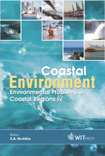Assessing The Linkages Among Climate Variability, Land-use Change And The Sedimentary Regime Of The Upper Chesapeake Bay
Price
Free (open access)
Transaction
Volume
58
Pages
Published
2002
Size
519 kb
Paper DOI
10.2495/CENV020171
Copyright
WIT Press
Author(s)
A P Barros & S J Gordon
Abstract
The objective of this study was to assess the effects of climate variability and land- use change in the Susquehanna river basin on the sedimentary regime of the Upper Chesapeake Bay, USA. Historical precipitation, stream discharge, land use, suspended sediment and dam reservoir capacity data were used to interpret regional patterns of erosion and sediment transport on annual, decadal and centennial time- scales. Sediment accumulation patterns in the Upper Chesapeake Bay were inferred from the analysis of four piston cores including 14C dating, magnetic susceptibility and laser particle analysis techniques. Core magnetic susceptibility profiles were found to be a useful tool for stratigraphic correlation on the order of centimeters. On annual to decadal time-scales, a strong relationship was found between sediment yield and regional rainfall-runoff patterns and land surface erodibility. However, on centennial time-scales, our research suggests that anthropogenic land -use change (e.g., clear-cutting of native forests) has caused up to an order of magnitude increase in sediment accumulation rates in the Upper Chesapeake Bay. As a result, the signature of extreme hydrologic events such as large floods and droughts, and thus Anatural@ climate variability, was "aliased" from the estuarine sedimentation patterns over the last 150 years. The construction of major dams around 1930 on the Lower Susquehanna River has resulted in a significant decrease in coarse fraction of sediment inputs into the estuary, further reducing our ability to separate flood episodes from average conditions.
Keywords





